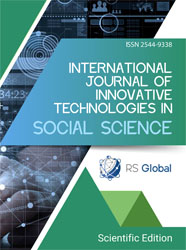REGIONAL SECURITY: THE CURRENT SITUATION AND FUTURE TRENDS IN CENTRAL ASIA
Abstract
In an interconnected world, the security of a nation is closely intertwined with the security of its neighboring regions. Regional security changes have the potential to significantly impact a nation's overall security. In the geopolitical and geo-economic scenario, the strategic position and possession of a state or region remains a challenging issue as evident from the evolving strategic scenario of 21st Century international politics. In this framework, the Central Asian region is considered to be of major strategic significance because of its geopolitical position. In addition, the region possesses some of the important energy resources, mainly oil and gas, and access to them is of strategic significance to all involved – regional as well as external players. This study aims to provide an overview of the current situation of Central Asian countries and their prospects in security. Geographically Central Asia, the central part of Asia, this region is directly bordered by influential players in international relations. Central Asia is bordered by the Caspian Sea in the west, China in the east, Afghanistan in the south, and Russia in the north. The region consists of former Soviet republics such as Kazakhstan, Uzbekistan, Tajikistan, Kyrgyzstan, and Turkmenistan.
Central Asia has been an area of geopolitical interest due to its strategic location and abundant natural resources. To understand the current situation and future trends in regional security, it is essential to consider a few key factors. First of all, the Political Stability: Central Asia comprises Kazakhstan, Kyrgyzstan, Tajikistan, Turkmenistan, and Uzbekistan. While these nations have made progress in political stability since gaining independence from the Soviet Union, challenges persist. Authoritarian governance, limited political pluralism, and ethnic tensions have occasionally affected stability in the region. Next, Terrorism and Extremism: Central Asia has faced the threat of terrorism and extremism, primarily from groups like the Islamic Movement of Uzbekistan (IMU), the Taliban, and now the Islamic State (IS). Also, it is Poverty, lack of economic opportunities, and political repression have contributed to the vulnerability of Central Asian populations to radicalization. The intricate balancing act of Central Asian states is examined through the concept of multi-vectors, a strategy used by these nations to diversify foreign alliances and resist domination by any single power.
References
Dr. N. Dorjsuren (Ph.D.), Dr. Ch. Sumiya (Ph.D.), S. Naranzul, P. Nyambayar, Ts. Munkhbayar, B. Byambakhand, N. Otgontamir, and project assistant Thelma Divry. Adiyasuren Jamiyandagva, Geo-economics in Central Asia: Great powers and Regional countries, National Institute for Security Studies and the Konrad Adenauer Foundation, page7. 04 July, 2023. Accessed at: https://www.kas.de/de/web/mongolei/publikationen/einzeltitel/-/content/geoeconomics-in-central-asia-great-powers-and-regional-countries.
ALIYA TSKHAY, Research Fellow University of St Andrews, China and Geoeconomic dynamics in Central Asia, /balancing global strategies, local interests and multiple partners/, Finnish Institute of International affairs, October 2021, 11-13. Accessed at: https://www.fiia.fi/wp-content/uploads/2021/10/wp126_china-and-geoeconomic-dynamics-in-central-asia_aliyatskhay-1.pdf.
B.Ankhtuya, Geopolitics with a focus on Central Asia, News. Mon, 08 July, 2023. Accessed at: https://news.mn/r/2653700/.
S. Showkat Dar, Strategic Significance of Central Asia in 21st Century, page2, https://ccas.uok.edu.in/Files/93269b6c-7f53-4439-ae9a-3bdf55a4c649/Journal/d746cf43-0d55-4f58-a74e-5f5a08fc7082.pdf.
https://wordspy.com/index.php?word=stans.
https://www.britannica.com/place/Central-Asia.
http://www.kremlin.ru, Concept of the Russian Foreign Policy, approved by the decree of the President of the Russian Federation DA Medvedev on July 12, 2008.
Konstantin Syroezhkin “The policy of Russia in Central Asia: a perspective from Kazakhstan.
V. Paramonov, A. Strokov “Russian Foreign Policy in Central Asia”, Central Eurasia – Politics.
Marie Raquel Freire “Russian Policy in Central Asia: Supporting, balancing, coercing or imposing? ASIAN Perspective, Vol.33, No.2, 2014, pp125-149.
V. Paramonov – Central Asian and Central Eurasian issues, such as regional integration, CIS, Collective Security Treaty Organization, Shanghai Cooperation Organization, policy researcher, expert, expert group leader.
The USA wants to transport cargo to Afghanistan through Russia., http://www.ukrgazeta.com/10440/.
Researcher's explanation: terrorism, separatism and extremism are called 3 evil forces.
The Diplomat, https://news.mn/r/2653700/.
Three Evils (三股势力): The Three Evils is a political slogan of the People's Republic of China, defined as terrorism, separatism and religious extremism. The phrase refers to declare counter-terrorism operations undertaken by China, Central Asian republics, and Russia, primarily as related to Xinjiang.
The EU and India are discussing joint infrastructure projects that can serve as an alternative to the BRI. For more details, see Peel, Fleming & Findlay 2020.
Soutullo, Gazzina & Rinaldi 2020.
European Commission 2021, ‘Central Asia – Trade’.
Alvaro Mendez, Russia’s Backyard: China and Central Asia after the Invasion of Ukraine, SPRINGER LINK, The Great Power Competition Volume 5, 10 Oct, 2023, pp 199–216, https://link.springer.com/chapter/10.1007/978-3-031-40451-1_10 https://link.springer.com/chapter/10.1007/978-3-031-40451-1_10.
Central Asia from COOPERATION AND COMPETITION: Russia and China in Central Asia, the Russian Far East, and the Arctic on JSTOR, Carnegie Endowment for International Peace, 2018, https://www.jstor.org/stable/resrep16975.6.
Pagma. A, Academia, Political and economic transitions in central Asian countries, New Mirror magazine, Number (40), 2002.
https://www.eeas.europa.eu/eeas/central-asia_en.
https://www.europarl.europa.eu/RegData/etudes/BRIE/2018/628265/EPRS_BRI(2018)628265_EN.pdf.
Views:
1048
Downloads:
349
Copyright (c) 2023 Oyuntsetseg Densmaa, Baasankhuu Suren

This work is licensed under a Creative Commons Attribution 4.0 International License.
All articles are published in open-access and licensed under a Creative Commons Attribution 4.0 International License (CC BY 4.0). Hence, authors retain copyright to the content of the articles.
CC BY 4.0 License allows content to be copied, adapted, displayed, distributed, re-published or otherwise re-used for any purpose including for adaptation and commercial use provided the content is attributed.











